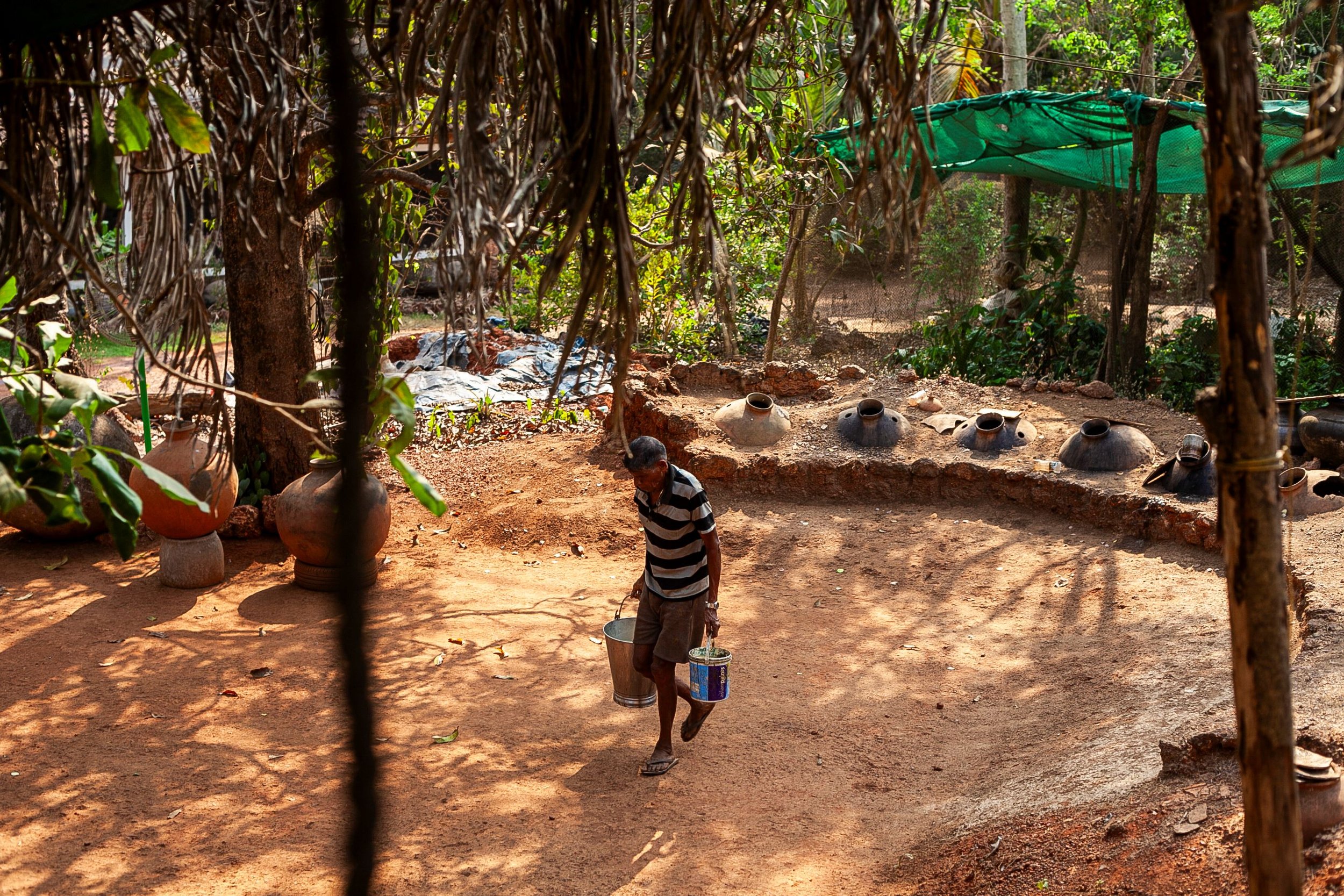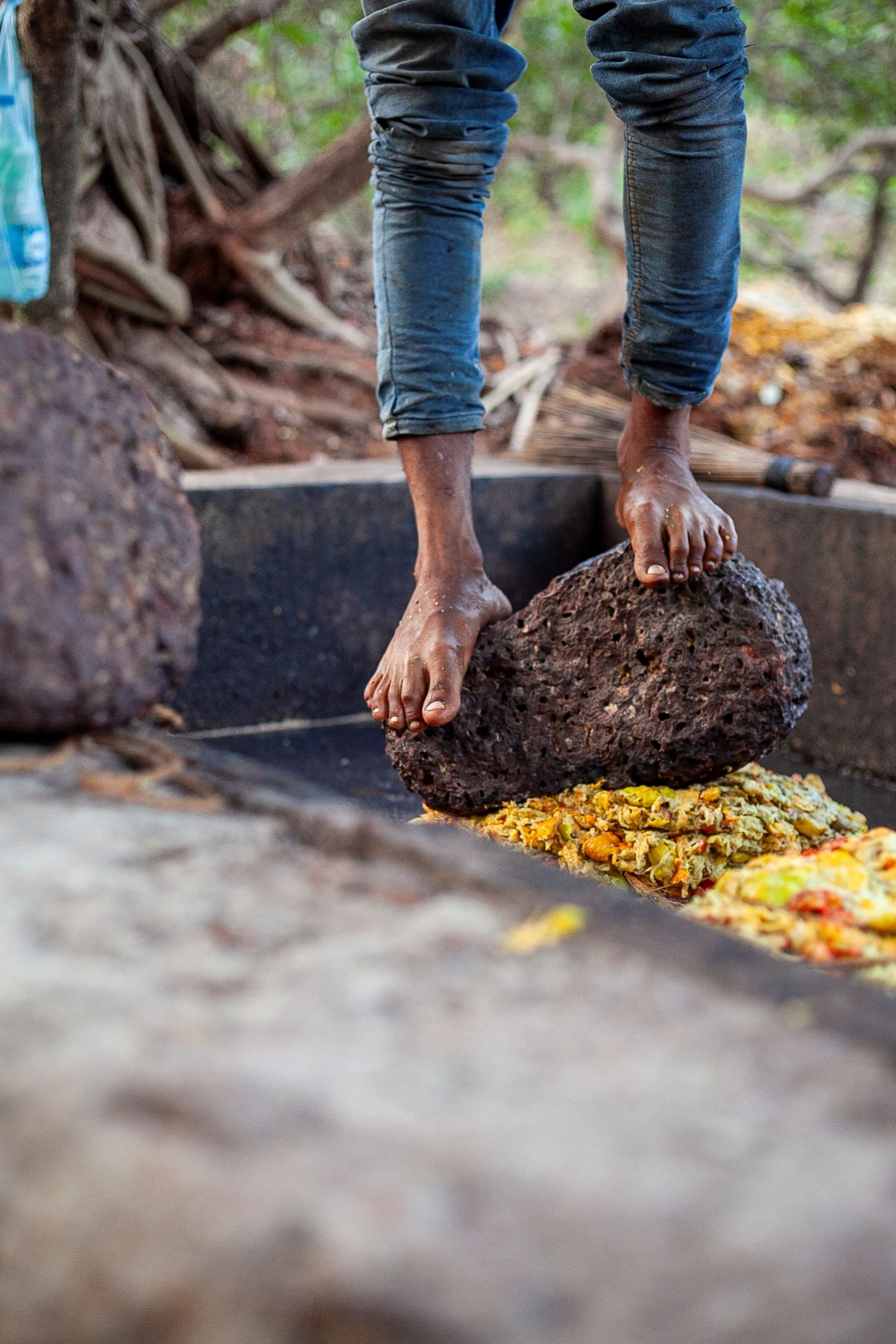The Making of Goa's Jungle Juice, Urraca

Nachiket Pimprikar dives into the heart of Urraca season at Hansel Vaz’s farm, Fazenda Cazulo. From harvesting the cashew fruit, to stomping, fermenting and watching the master distiller work with Goa’s traditional equipment to coax out the state’s beautiful urraca, a low-ABV fermented cashew beverage that is unique to this part of the world.
For a taste of urraca, join us in Goa on April 12th, for an Urraca tasting by Goya & Hansel Vaz. Tickets available here.
Urraca season coincides with the peak of summer in Goa. This year, summer came early; temperatures in February touched an unprecedented high. Urraca is the first distillate of fermented cashew juice, a light, summery and absolutely delicious beverage. Urraca is held up by an artisanal industry and a fascinating culture of its own, unique to the state of Goa.
Tyson Da Costa, at Hansel Vaz’s distillery Fazenda Cazulo, explains that the cashew flowers twice a year – once in November, when it burns out because the dew and mist in December; and again in January and February. “From the flower, a nut develops, then a stem. Interestingly, the cashew is actually a false fruit – it is actually the stem that swells and turns yellow, orange or red, that is known as the cashew fruit.”
In Goa – and this culture is unique to Goa,” he points out, “We go out to pick cashew in the afternoons, at the highest point of heat in the day. The heat weakens the stem of the ripest fruits, and the cashew falls from the tree. This is when we go cashew picking.” Farmers use branches with thorns, and tribals often use a porcupine nail tied to a long stick. This becomes an extended arm in the fruit-picking, allowing them to pick the fallen fruit, and collect them in buckets. “It is also a matter of caution, because there are snakes and scorpions on the forest floor.”
The cashew is then brought to the nearest crushing point. The cashew industry is often run by tribal and village folk who have limited access to resources, and cannot afford expensive machinery to support an industry whose season lasts only 3 months. So the fruit and nut are separated by hand. The nuts are sold, and the fruit juice is extracted manually, by stomping.
The first juice extracted is transferred to be fermented in earthen pots half-buried in the ground. This works as natural temperature regulation, and prevents the pots from exploding.
This second extract is consumed as fresh juice called niro. After the first extract, the pulp is piled into a little mound, secured with coconut coir, and using a hydraulic stone press, the pulp is squeezed for a second extract of niro. Niro is a highly sought-after drink, delicious and rich in vitamin C, but with a very short shelf life. People from neighbouring homes in the village often gather at this time with empty bottles, to carry back fresh niro from the pulping.
Any leftover niro is added into the fermentation pots along with the first extract. Fermentation of the first extract happens naturally, with natural yeast from the atmosphere. Within 3-4 days, depending on the temperature, the bubbling stops. The master distiller does a check, and on his word, distillation begins. If the juice is left to ferment beyond this time, the beverage will turn to vinegar.
It is believed that the science of distillation came to Goa from the Persians, through their study of medicine and perfume. Traditionally, some varieties of feni were administered as medicine, one of which was known as ‘dukshiri’ for its ability to relieve pain and body ache. Eventually, the science of distillation spread, and was used in consumption because of its unique ability to extract flavour.
In the distillery, this fermented first extract is then poured into a pot, and sealed with a mud pot upturned over its mouth. This prevents any fumes from escaping once the fire is lit. The pots are then sealed with mud – specifically, mud from an anthill. “The saliva that ants add to the mud lends it a natural sticky texture. We grind this mud to a fine powder, dampen it with a cotton cloth, and seal the pot. When the fire is lit, the sealant becomes hard and strong.”
A bamboo stick is attached to the pot to channel the fumes to a water tank, where a copper pipe coiled within the tank cools the steam down to condensation. This is then collected as urraca, the first distillate of fermented cashew juice. To make feni, urraca and fermented cashew juice are put back into the distillation pot and distilled a second time.
Most fascinating to this process is that unlike commercial distilleries that work with temperature gauges and regulators, urraca and feni depend on the highly skilled role of the master distiller. He watches the fire, listens for the sound of boiling within the pot; he touches the vessel to understand the rising of temperature and studies the alcohol emerging from the still. Relying solely on these tactile measures, he creates a balanced liquid, maximizing on flavour, retaining only the body of feni, discarding the head and tail.
Feni is rooted in the Sanskrit word Phena, meaning bubbles — a key point in making of feni. Once feni is collected from the still, the master distiller pours the liquid back and forth in chai glasses, watching closely for a bubble that bursts at precisely 1/10th of a second. This informs him that his beverage is at 42.8 ABV – the required ABV for feni in the state of Goa.
Words by Tyson Da’Costa, and photographs by Nachiket Pimprikar.
For a taste of urraca, niro and feni, join us in Goa on April 12th, for an Urraca tasting by Goya & Hansel Vaz. Tickets available here.
ALSO ON GOYA
































